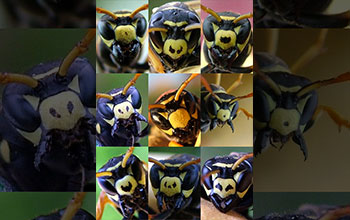Multimedia Gallery
Mosaic showing paper wasp variable black facial patterns
A mosaic showing paper wasps with variable black facial patterns, which signal their fighting ability. Wasps with more of these irregular black spots on their faces win more fights and are avoided by rivals.
More about this image
A study by researchers at the University of Michigan (U-M) is providing new perspective on honest communication by showing that paper wasps that send dishonest signals are aggressively punished, and the drubbing can have long-term impacts.
Paper wasps have a variety of black facial patterns that signal their fighting ability. The more irregular black spots a wasp has on its face the more fights it will win and rivals will avoid it. These facial signals help reduce the cost of conflict, ensuring that wasps that are more timid do not waste time battling much stronger rivals they are unlikely to beat.
For the study, Elizabeth Tibbetts, an associate professor in the Department of Ecology and Evolutionary Biology at U-M and first author of a paper published on the topic, and colleagues had pairs of female paper wasps (Polistes dominulus) battle to examine how signals contained in the wasps' facial patterns influenced social interaction and hormone levels in both the signalers and in the wasps that interacted with them.
In the spring, Tibbetts collected paper wasp queens from around Ann Arbor--a time of intense conflict between queens as they compete to establish nests. Each female wasp was paired with a rival of similar size. The wasps were placed in a small, Plexiglas box, where they battled for a two-hour period as researchers videotaped. For the battle, one wasp, called the "bluffer," was painted so its facial patterns signaled inaccurately high fighting ability while the other wasp remained unaltered. Aggression in the matches was scored based on the number of mounts, bites, grapples and stings observed.
Following the matches, the wasps were bled for analysis of their juvenile hormone (JH) levels--an invertebrate hormone with strong functional parallels to androgens, the male sex hormones in vertebrates. High levels of JH are linked to dominance, aggression and increased fertility in paper wasps.
The researchers found that wasps that signaled an inaccurately high fighting ability received more aggression than control wasps, and that receiving aggression reduced their JH levels immediately after the match. In the wasps that battled the bluffers, JH levels increased after the bout.
"One of the interesting things about the paper is that it shows that cheating influences the physiology of cheaters and individuals who interact with the cheaters," Tibbetts said. "That was a surprise."
An individual's evolutionary fitness is likely to be altered even by temporary changes in hormone levels via the persistent effect of hormones on morphology, physiology and behavior. In wasps, JH influences social rank and determines lifetime reproductive opportunities. "Therefore, JH downregulation at the time of nest foundation may have long-term costs," said the researchers in their study.
The research was supported by the National Science Foundation (grant IOS 11-46139).
To learn more about this research, see the U-M news story Dishonesty is aggressively punished in the world of paper wasps. (Date image taken: unknown; date originally posted to NSF Multimedia Gallery: Oct. 4, 2016)
Credit: Elizabeth Tibbetts, University of Michigan
Images and other media in the National Science Foundation Multimedia Gallery are available for use in print and electronic material by NSF employees, members of the media, university staff, teachers and the general public. All media in the gallery are intended for personal, educational and nonprofit/non-commercial use only.
Images credited to the National Science Foundation, a federal agency, are in the public domain. The images were created by employees of the United States Government as part of their official duties or prepared by contractors as "works for hire" for NSF. You may freely use NSF-credited images and, at your discretion, credit NSF with a "Courtesy: National Science Foundation" notation.
Additional information about general usage can be found in Conditions.
Also Available:
Download the high-resolution JPG version of the image. (5.5 MB)
Use your mouse to right-click (Mac users may need to Ctrl-click) the link above and choose the option that will save the file or target to your computer.

 All images in this series
All images in this series